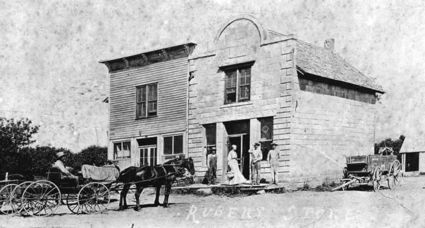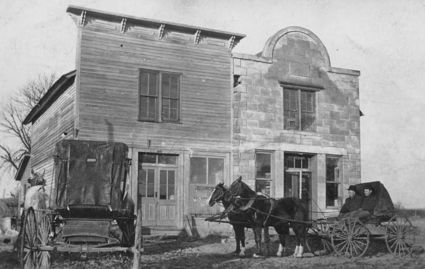Fish holding school in Reubens
Townsite covered 1957 by Lovewell Lake
April 30, 2020

This is a post card picture of Rubens Stores in 1908. The remains of Rubens was covered by water when Lovewell Lake was filled.
John's Creek meanders north through Jewell County's Richland Township. It was doing so 150 years ago when the first permanent settlers were establishing homes in Jewell County. At that time, White Rock Creek flowed eastward across the breadth of Jewell County.
Near where the two creeks came together, the town of Rubens flourished during the late 1800s. It began on Jan. 31, 1871, when the Rubens Post Office, named after the first Rubens postmaster, William Rubens Scott, was established. The first home in Rubens was a cabin built by William Scott, Samuel Sweet and Willis (Wilson) McBride.
The three built a cabin on the exact intersection of their homesteads. They lived together for their mutual protection. Being built on all three homesteads, the cabin met the requirement for a home that all homesteaders had to meet. According to a March 2, 1887, Jewell Monitor article, the homesteads, and eventually the town, were located at the intersection of sections three, four, nine and ten in Richland Township.
William Scott seems to be one of the many Civil War veterans who came west after the war. Little is known about him. He and his wife, Julana White Scott, moved from Rubens to the White Rock area of Republic County. William Scott died in 1873 and Julana in 1898. Both are buried in the White Rock Cemetery.
Wilson Polk McBride was born in Ohio in 1845. His name is found in the 1870 Jewell County Census. Married to Margaret West in 1873 in Iowa, their four children were all born in Jewell County. The family moved sometime after 1880 to Oklahoma. Both he and his wife are buried in Hunter, Oklahoma.
The third of the three men to locate first at Rubens was Samuel Sweet. From Ohio, he was 22 years old when he came to Kansas. His name is one of the 200 and some enumerated in the 1870 Jewell County census.
Sweet became the second Rubens postmaster on Sept. 26, 1871. Samuel and his wife, Enola Ross Sweet, were married in Brown County, Kansas, on May 16, 1878. They lived in the Rubens area until 1891 when they moved to Republic County. Their great-grandson, Harold Sweet, currently lives in Superior, just a few miles from the Sweet homestead.
According to another newspaper clipping, it was in 1877 that C. J. Kinkade and E. T. Taylor decided the area (south of White Rock Creek and east of where John's Creek joined the White Rock) was a good place for a town. The two men each built a home at the intersection where the three early settlers built their cabin. The town of Rubens began to grow.

The decision to build must have been made early in 1877. According to the Jan. 13, 1877, issue of the Jewell County Monitor, the Rev. A. R. Naylor was scheduled to hold services at Rubens on Thursday at "early candle light." In February, West & Co. and Dr. Taylor & Co. were blasting rock to build businesses in the new town. By May, Crouch and Kinkade had opened a drug and grocery store. The Hunter and Bro's store was open by December.
For some years the two men were right, it was a good place for a town. The March 10, 1881, edition of the Jewell County Review, carried a lengthy article about Jewell County's post offices, towns and businesses. A section was devoted to the town of Rubens.

The article lauded Rubens for having the only grist mill in the county. A Mr. Wright had been convinced the flow of water in White Rock Creek could power a mill. He built the first dam and wheel. His mill was a one-burr mill for grinding corn.
Then a partnership, Ritterbush and Wright, was formed. Andrew F. Ritterbush was born in Germany in 1840. Another of the Civil War veterans who came to Kansas, Ritterbush was in Clay County, Nebraska before he came to Jewell County. He and his wife Sarah were in Jewell County around 1875.
The partnership, Rubens Mill, built a new wheel, new dam and larger mill. The new mill had two burrs for grinding wheat as well as the original one for corn. An item in a paper noted when the two men came to town covered in flour, it was "the only advertising they use."
The business did well. One newspaper item claims the mill ran 24 hours a day. In 1882, a well was drilled to supply water for "the customers." It was likely the water was for the horses and mules of the customers as another clipping noted how many teams and wagons surrounded the business. In June of 1883, A. F. Ritterbush was the sole proprietor of Rubens Mill.
In 1885, Ritterbush sold the mill and moved to Nebraska with plans to have a mill on the Little Blue River. He eventually went to Cherry County, Nebraska. After his departure, there is no more mention of Rubens Mill in area newspapers.
At the time of the 1881 article, C. J. Kinkade was postmaster and had "general merchandise" and "patent medicines" for sale at the post office. There were also two doctors, T. Reitdzell "M. D. and Druggist" along with A. A. Webster "M. D. and Druggist." Dr. J. M. Larrabee was a homeopathist practicing in the community in 1888. Dr. H. J. White began his practice in Rubens in 1883.
Plus, there was Dr. E. T. Taylor. In addition to his "renown as a cancer doctor," Taylor had a "little bit of everything" for sale in his store. As a founder of the town, Taylor had one of the first businesses in Rubens.
Bill Roe, Mankato, recalls his grandfather, "Old Bill Roe," talking about the hired men going to Rubens to get plugs of tobacco. Perhaps they could have been going to Dr. Taylor's business with its "little bit of everything." It will also be here noted that Taylor was twice arrested and once tried, convicted and sentenced in a Topeka court to 30 days in jail for selling liquor without a license.
Through it all, local items indicate the good doctor was a popular person. He stayed in the Rubens area until the 1890s when he moved to Colorado. C. J. Kinkade, who along with Taylor, started Rubens' growth, also left the area. Kinkade was in Concordia by 1883.
Rubens' biggest store, the most "stylish" and with the "largest stock" of goods, belonged to Oliver S. Rice. Rice was born in 1817 in Massachusetts and married Juliet Lough in Illinois in 1840. They came to Jewell County with their four children before 1875.
He and his family first located in Montana Township, the township immediately north of Richland. There he ran the "Montana Store" out of his dugout. When Rubens began to spring up, he built a building and moved his business to Rubens. In the June 5, 1889, issue of the Monitor, he is referred to as the "Pioneer Merchant." Both Oliver and Juliet are buried in the Webber Cemetery.
Felix. T. Gandy was also an early businessman. He ran an implement store, selling "agricultural implements." He also sold Studebaker wagons. Gandy and his wife, Belle Carmichael Gandy, were from Iowa. Belle Gandy died in 1883 and is buried in Montana Cemetery. After her death, Felix left Rubens and moved to Sherman County in western Kansas. There he founded the town of Gandy and was at one time the postmaster there.
The flourishing community also had the Rubens House. The hotel was run by Aurin O. and Julia Meeker Hunt. Mr. Hunt was described as "attentive" but the "charm of the house" was due to Mrs. Hunt. They had a "good stable" beside the hotel for the horses of their customers. The Hunts came from Pennsylvania. Aurin Hunt was serving as the Rubens postmaster when he died in 1888. It is not known where or when Julia Hunt died.
Goldie Jacobs Roberts, originally from Montrose but now living in Shankio, Oregon, recalls her great-grandparents, William and Mary Massie Bales, were also involved with the hotel. William was a respected and well-known area blacksmith. He had a blacksmith shop in Rubens but at other times had shops in Gregory, Burr Oak and Holmwood. Theirs is a sad story in the history of Rubens.
In 1911 the couple, both in their late 60s, lived a mile west of Rubens on a rented farm. Harve Wadleigh, a nearby neighbor, was known by them and considered a friend. On the morning of Jan. 26, 1911, he came to their home, then shot and killed both of them.
Wadleigh simply went back home and waited for the sheriff to arrive. He was arrested without issue, brought to trial and found innocent by reason of insanity. He was then committed to an insane asylum. William and Mary Bales are buried in the Burr Oak Cemetery.
Another incident in Rubens' history involves Rubens School District 21. Incidentally, the school was organized March 11, 1882 and was disorganized on July 1, 1951. However, there are no records of teachers hired after 1946 so it is possible school was not held during those years.
In May of 1905 the school house was a "hopeless wreck" after being hit by a wind storm that moved it "about four feet north and east." It was "like a huge watermelon which had fallen about 10 feet." The community needed a new school and one was built. The new school was equipped with an organ donated by the Sunday School.
In September of 1906 the school burned. Arson was suspected and F. J. Klinker of Rubens was arrested. He was arraigned and tried. Numerous newspaper items discuss his arrest and trial. No items or articles discuss the verdict. Klinker remained in the area. J. J. Henderson had the contract to build a new school. It was to be completed by mid-November.
Throughout the years of the town's existence there were numerous other businesses. Mrs. M. E. Nunnally had a millinery shop in 1879 and 1880. Ray Derlan had a saw mill. There was also May & Stallard who had a molasses factory south of town. In 1901, Mr. Pomeroy opened a store with a "full line of merchandise." W. Kier ran a clothing store in 1885.
Several men had blacksmith shops in Rubens. William Bales has already been mentioned but there was also W. B. Nunnally and W. A Wall.
Rubens had a Grange Hall. For many years the Rubens Social Club had regular meetings. On July 28, 1894, the Rubens Equal Suffrage Club was organized. Eighty-one members signed up at the first meeting. By mid-September, they were calling for an Equal Suffrage Committee in every township and there was already a committee in Burr Oak. Equal suffrage was not to be won for another 25 years. The Equal Rights Amendment was finally ratified in August of 1919.
Rhoda Lovewell, the youngest granddaughter of early White Rock settler Thomas Lovewell, now lives in Viking Lake, Missouri. She remembers being in the town of Rubens and in a store with her father. She was very young and it was a time when "children were seen and not heard."
Zenetta Montgomery Schenck, Central City, Nebraska, tells about her great-grandfather, Richard Montgomery. Montgomery was born in New York in 1811 and with his wife, Sirviah Marsh Montgomery, made the trip to Richland Township around 1875. Two of their five children came with them. He died in 1877, shortly after they arrived.
The family story says he was buried on the hill in Richland Township where he shot his last buffalo. Two granddaughters are buried there also. There is a cemetery marked Montgomery-Dunlap on old maps but it is not known if it still exists.
Burt Warne of Mankato also grew up near Rubens. His father's family farm was taken when the lake was built. Warne attended Rubens School. He remembers the town but never as a thriving community. The Rubens Store was the last thing left and it burned sometime in the 1920s.
Some like Nils Cederberg didn't live in the town but were part of the rural community. Born in 1838 in Sweden, he immigrated to the United States in 1865. Cederberg was one of the group of settlers who came to Jewell County in 1869 to locate homesteads. He, like all but Peter Kerns, did not spend the winter of 1869-1870 in Jewell County. One might speculate he spent the winter of in Geary County. It was there he married Mary Ann Westerdahl, also born in Sweden, on Oct. 29, 1870.
The Cederberg homestead was just a mile west of Rubens. They raised four sons and a daughter on their farm. The couple remained in Jewell County the rest of their lives. Mary Ann died in 1894 and Nils in 1913. They are both buried in Mount Hope Cemetery near Mankato.
Rubens flourished and then withered. But the final death knell came with Lovewell Lake. A dam was built and in 1957 the lake began to fill. What was left of Rubens, along with the old homesteads and farms of the community, was covered with the waters of the lake.
When the lake is low, one is supposed to be able to see the remnants of Rubens. Perhaps the last person to be in Rubens was Bill Logan of Mankato. Once when the lake was very low, he rode his horse through the vestiges of the once bustling town.







Reader Comments(0)